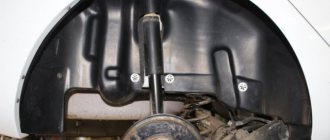In the last post I talked about the two-liter MR20DE engine, now I will tell you some information about the HR16DE.
Let's start with its decoding:
HR: The first two letters HR act as the name of the engine series. 16: Dividing by 10 we get the engine volume. 1.6 liters. D: The engine has 4 valves per cylinder and 2 camshafts. E: Multipoint, electronic fuel injection (injectors).
Story
Production began in 2006 and is still produced to this day. It was first installed on Nissan note, Nissan Tiida and Nissan Micra, then on Nissan Qashqai, Nissan Juke and others. Just like MR20DE, it is also installed on Renault cars. Starting from March 15th, its production will start at AvtoVAZ under the name H4M, the engine will be equipped with Alliance cars (Renault-Nissan) and promising AvtoVAZ models - Lada Vesta and XRAY. In addition to IzhAvto, the engine from VAZ will also be supplied to the Moscow Renault plant. It was previously reported that localizing the motor would cost 18.9 billion rubles, and production volume could reach as much as 450 thousand units per year. In terms of characteristics, the VAZ H4M will be practically no different from the HR16DE, with the exception of slightly more (literally 12 units) torque at 4400 rpm.
A little about reliability
An absolutely unremarkable engine, in practice it is capable of driving more than 250 thousand km. It is not demanding on gasoline; with the recommended 95, you can safely fill it with 92.
Known Issues
1) Engine whistling. The problem lies in the alternator belt; the problem can be solved by tightening it or even replacing it. 2) Burnout of the exhaust pipe ring; at mid-range speeds, a more “aggressive” sound is heard when accelerating. Solved by replacing the gasket. 3) Engine vibration. Usually, this is a symptom of imminent failure of the right engine mount. In this case, replacement is required. 4) The engine suddenly stalls. The problem is in the ignition unit relay; because of this malfunction, Nissan even recalled an entire batch of cars. The problem is solved by replacing the ignition unit relay.
Engine characteristics
Engine brand - HR16DE / H4M Cylinder block material - aluminum Power system - injector Type - in-line Number of cylinders / valves - 16 Piston stroke, mm - 83.6 Cylinder diameter, mm -78 Compression ratio - 9.5 Engine displacement, cc - 1598 Engine power , hp/rpm — 110-117/6000 Torque, Nm/rpm — 153/4400 Engine oil — 0W-20, 5W-30 How much oil is in the engine — 4.6 l When replacing, pour — 4.3 l Engine life, thousand km - according to the plant - n.d. — in practice — 250+ Engine tuning — potential — 150+ — without loss of resource —
Quoting one Drayvovchanin I will say: “Tuning is pointless”)))
Purchasing a new car is a complex process, since from a large number of options you need to choose the best one in terms of functionality and cost. Costing approximately the same, the Lada Vesta and Nissan Almera G15 are of great interest to people who want to buy a good car for not a lot of money. Which car is better in terms of design, interior and technical characteristics?
Whose salon is better?
In terms of interior configuration and ergonomics, both models do not differ categorically, however, the Russian car has a number of competitive advantages.
The interior of the Nissan Almera G15 is a big loser, as it looks boring and unassuming against the backdrop of its impressive appearance. There are no innovations here: the dashboard is copied from Logan. The interior is designed in one gray tone, the plastic is cheap, the air nozzles are round, and the aluminum inserts stand out as foreign and unnatural. This interior is not at all conducive to a long stay in the car. The only thing that can catch the eye is the chrome-plated edging of the ventilation system holes and the steering nameplate.
As for the ergonomic characteristics here, things are going well. Conveniently located keys, an informative dashboard, but the seats are not very comfortable. The rear is spacious, making the car suitable for large families. The sound insulation is let down and while driving you can hear the engine running in the cabin, the whistling of the wind outside the window, the sounds of falling raindrops, etc.
Lada Vesta pleases with a spectacular interior with a branded multi-function steering wheel and an informative instrument panel. Despite the fact that the plastic is not of the highest quality, it looks high-quality and organic. Contrast is provided by chrome trim. The seats are more comfortable than those of the Almera, but the second row is tighter than that of its competitor. In terms of visibility and sound insulation of the interior, Vesta greatly benefits from comparison in Almeroy.
Main prospects for the development of the Russian Lada Largus project
In the form in which it is now, the Largus project will not be able to exist. We'll have to work hard to maintain the model's potential popularity. And the main efforts will be in updating the design, changing power units to decent options, which is important, and also in decoupling the cost of the car from the foreign exchange rate. There are many options for further actions by the company that will help completely change the fate of the currently not entirely successful model. Among the most popular proposed steps, the following solutions are quite adequate for the company:
- development of a new line of engines that would meet the requirements of environmental friendliness and power;
- purchasing the design of a new generation Renault Logan car or carrying out a facelift;
- replacement of all imported components of the car, of which there are too many in the design today;
- complete change of interior design features, improvement of driver ergonomics and ride comfort;
- work on the practicality of the car, changing the suspension, which today causes a lot of discomfort to rear passengers;
- increasing the vehicle's carrying capacity for use as a cargo van with two passenger seats;
- addition of complete sets with more comprehensive technologies for comfort and ride quality.
It should be noted that most of the proposals come from customer reviews about Largus. Many people condescendingly say that this is a quite good invention of the Russian automobile concern. Others claim that there was no point in inheriting Renault Logan if Largus was actually made objectively worse. In terms of cost, a car today in the cheapest configuration in the form of a 5-seater station wagon costs 500,000 rubles, which in no way explains the meaning of the Russian production of the car. Many questions have accumulated for the domestic manufacturer, and these questions need to be given a worthy answer. We invite you to watch a review of the Lada Largus Cross:
Who is better in terms of technical characteristics, Vesta or Almera?
Vesta is available on the market with 106 horsepower 1.6 liter engines. and a 1.8 engine producing 122 hp. Nissan is represented by a 1.6 liter engine. power 102 l. With. Both models are equipped with a manual or automatic transmission, but for Nissan it is a classic hydromechanical automatic transmission; for Lada it is a robot.
The main difference is the fact that Vesta is available in different body types (station wagon and sedan), while the Japanese one is only a sedan, that is, in this regard, the Russian car has a clear advantage.
Engines
Engine characteristics of Lada Vesta (1.6 l VAZ-21129 - 1.8 l VAZ-21179):
- power 106 hp - 122 hp
- torque 148 rpm. — 170 rpm
- engine type 4-cylinder, in-line - 4-cylinder, in-line
- number of valves per cylinder 4 - 4
- acceleration to 100 km/h with manual transmission 11.2 sec with robot 14.2 - with manual transmission 10.2 with automatic transmission 12.1 sec.
- Lada also offers customers a Vesta with a 1.6 liter engine, equipped from the factory with gas equipment, which is an undeniable advantage.
Characteristics of Nissan Almera G15 (1.6 K4M):
- power - 102 hp
- torque - 145 rpm
- engine type - 4-cylinder, in-line
- number of valves - 4
- acceleration to 100 km/h with manual transmission 10.2, with 4 automatic transmission - 12.7 seconds.
Almera's power plant has no alternative.
Who is more economical?
Comparison of fuel consumption of Lada Vesta and Nissan Almera.
Features and innovations
Sales of the Lada Vesta station wagon started in 2020. The station wagon has become an almost exact copy of the concept car shown to the general public in 2020. The volume of the interior and trunk has brought the Lada Vesta to the forefront of its price segment. Inside, the car has become even more sophisticated than the 2020 model year sedan. High ground clearance allows you to actively use the car in rural areas. Unlike Vesta Cross, the car did not receive a body kit and a dual exhaust system, but according to technical parameters, these two cars are identical.
Lada Vesta SW received a standard multimedia system with wide functionality (MMS). Only the most “empty” configurations received a simple audio system. Having compared all the disadvantages of previous AvtoVAZ models, the manufacturer decided to release a completely new car. The body parts were galvanized, and according to the manufacturer, it was also internally galvanized. It is still difficult to judge the quality of the zinc coating on the body, since the new models are only a couple of years old.
Just like other modifications of the Lada Vesta, the station wagon is offered with two types of engines, paired with MT and AMT. If everything is clear with a manual transmission, then many motorists are wary of a robotic transmission. Today, there are many reviews from customers saying that the “robot” somewhat slows down the dynamics of the car.
Body
The new body of the Lada Vesta SW gave the car a certain completeness that was so lacking in the sedan. The Cross modification, released along with the classic station wagon, received the same body. It was decided to hold off on serial production of the Sport modification for now.
The SV modification has family features of the entire Vesta family of cars. The same X-shaped body shape, optics and other details characteristic of Vesta. In the station wagon body, the car received a streamlined roofline that smoothly flows into the luggage compartment, something that the sedan lacked. The car looks sporty, although VAZ engines cannot be called dynamic.
Lada Vesta SW has several serious differences from the Cross modification:
- The tire diameter of the SV is smaller, only 16 versus the 17-inch wheels of the Cross;
- The ground clearance of a simple station wagon is 178 mm, and that of the off-road version is 203 mm;
- The Cross body is larger in size, but this is only due to the presence of the original plastic body kit of the off-road model;
- The SV version does not have plastic engine protection;
- Cross has different springs and shock absorbers;
- It is not possible to purchase a classic station wagon in the signature Mars orange color.
The simple SV station wagon does not have the original orange interior trim of the Lada Vesta Cross. The usual modification is suitable for those who operate the car most of the time in urban environments. The smaller diameter of the wheels will make the SV more economical, although the volume of the huge trunk will allow it to transport even large cargo.
Lada Vesta SV is offered in comfort, comfort/image, luxe/prestige, luxe/multimedia trim levels. The latest modification is offered in the most complete configuration. Judging by customer reviews, expensive modifications have a higher build quality. The cheapest package will be the comfort MT 106 l. With. (engine capacity 1.6 liters).
Today the car is offered in the following colors: Glacier White, Anchor Brown, Dark Blues, Carnelian Red, Phantom Blue Grey, Platinum Silver, Pluto Grey, Black Pearl Black.
Salon
The interior of the Lada Vesta SW immediately attracts close attention. Unlike previous AvtoVAZ models, it is made with high quality and accuracy. The only thing that immediately alarms me is the specific smell in the cabin. Only budget plastic smells like that, nothing can be done about it. It is tough and dullly responds to knocks anywhere. It immediately becomes clear that it is better not to remove it unless absolutely necessary, as it may break. The decorative plastic insert in the doors and panels also raises many questions. If you press your finger on the headliner, it will press through. The quality of the floor mats in the cabin is also not great - they smell strongly of rubber.
If we compare the station wagon with budget models from other manufacturers, it turns out that the interior of the Lada Vesta SV is not only not inferior, but often superior to them. Despite the obvious superiority in price and size, some details still betray the budget nature of the domestic station wagon. There is not a single niche for rear passengers. The rear doors lack cup holders and storage compartments. In the back row, you can only use the pockets behind the front seats. But the front passenger is lucky; he has a glove compartment with two compartments, a cup holder and an organizer.
The luggage compartment of the station wagon is striking in its thoughtfulness. Under the double floor, the designers placed an organizer, there is a 12 V socket, a pocket for washer fluid, and a hiding place for tools. To prevent shopping bags from spilling their contents, there are special hooks in the luggage compartment, there are four of them. With the seats folded down, the luggage compartment volume is 825 liters.
Vesta SV has a new multifunctional armrest. Underneath it there is a USB connector, boxes for small items, and a 12 V socket. In expensive versions there is a multimedia system with a touchscreen. It also works with a rear view camera that turns on when driving backwards. Overall, the music sounds great for the budget segment.
Characteristics
Lada Vesta SW, like all modifications of the Vesta line, have only two engines. This is a 1.6 liter engine, developing 106 hp, and a 1.8 liter unit, developing 122 hp. The latest engine has always been distinguished by its oil burner, ever since the time when it was installed on the Priora. For the Lada Vesta SV, the engine was seriously modified, it was named 21179. The engine consumes oil even after modification, this is its design feature.
A station wagon is heavier than a Vesta sedan, and it will have to carry larger loads, so it is recommended to choose a more powerful 1.8-liter engine for the car. With this engine, the car becomes more obedient to the driver. You don’t have to be afraid of overtaking at high speeds, since the power of the 1.6-liter “brother” is clearly not enough. Despite the increase in power, 21179 cannot be called a record holder in terms of dynamics. But the car’s traction increases, which is very important for a station wagon.
The fuel consumption of Vesta in a station wagon is too high for modern cars of this size. If in the 200s, consumption in the city of 11-12 liters was considered normal, now this is unacceptable. AvtoVAZ must urgently develop new models that will match the sporty appearance of the Vesta family.
Judging by the reviews of the owners, the 1.8 engine is much louder than the 1.6 liter version. This can be heard especially well at high speeds; the standard sound insulation of the Vesta SV is really budget-friendly.
The manual transmission on the station wagon works more smoothly than in the sedan. It is not clear how the manufacturer managed this, but changing gears in the SV modification is easier than in the sedan. The car's suspension is very ergonomic; the manufacturer has developed new springs and shock absorbers for the station wagon. The suspension setup is stiffer than in a classic sedan. This is understandable; such vehicles are often used to transport heavy loads. As for the brakes, they do their job perfectly on all vehicles of the Vesta line. The steering is informative.
Rumors about the release date of trim levels with different engines
We have information provided by two sources:
- “Volzhsky Autobuilder”, November 2020 – Vesta sedans will be equipped with engines with index 21179 from October 2016;
- Unofficial source, December 2020 – Nissan engines in Vesta car configurations will appear before the start of production of engines 21179.
That is, configurations with a Nissan engine should not appear later than “top” engines with a volume of 1.8 liters begin to be produced. Everything looks logical here: the buyer should have a choice.
Now let's compare the two statements. It looks like the Lada Vesta with a Nissan engine will appear at VAZ dealers in October of this year! The forecast looks bold, but it does not contradict logic.
At first glance, there is nothing remarkable in the design of the H4M engine: the volume of four cylinders is 1.598 liters, and two shafts push 16 valves. The cylinder block itself is made of aluminum, and usually hydraulic compensators are installed in such engines. But there are none here - instead, a system is used that changes the valve opening parameters depending on the load.
The main dispute is what engines are on the Lada Largus?
French power units are installed under the hood of the Russian car. Two versions of the engine migrated under the hood of Largus directly from the assembly lines of the Renault corporation, however, their production is carried out in Romania. Today these same engines are installed on new versions of Sandero and Logan. True, the buyer will not receive any special impressions from the operation of such a power unit. The fact is that the engine technology is already quite outdated, which was the main reason for the sale of the technical model of the car to AvtoVAZ. The French have provided several completely new engine options for their new products, and the technical characteristics of Largus units have the following features:
- The 1.6-liter unit is presented in a single technology - the simplest and most standard aspirated engine;
- there are two versions of the engine, which differ in design by an 8- and 16-valve system;
- the power of the French power unit is 84 or 105 horsepower according to the number of valves;
- the engine potential is quite good, torque reaches its peak already at 3000 rpm;
- gasoline requirements are exclusively fuel with an octane rating of 95, not lower than this figure;
- the engine accelerates the car to 165 kilometers per hour, and the fastest version reaches a hundred in 13.1 seconds;
- In the technical part, we need to pay more respect to the gearbox, which is not the strongest unit.
The engine is surprisingly simple and not too dynamic; it likes low revs and handles heavy loads quite well. That's why it's good for a station wagon. To date, two gasoline engines have turned out to be a complete set of the manufacturer’s technical proposal. Unfortunately, and for some fortunately, the VAZ corporation did not endow Largus with its own power units. However, until the end of 2015, it did not have the right to do this due to patent obligations. Therefore, in the near future we may see several major updates in powertrains and other features of the car. It must be said that buyers are still confused by the lack of automatic versions.











